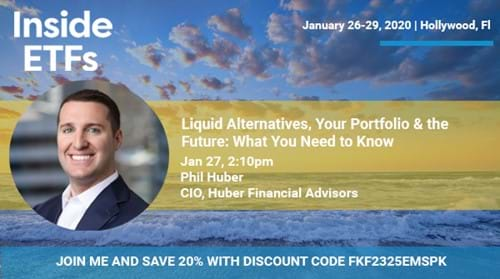Surviving and Thriving in a Two Asset World
Next week I’ll be making my annual pilgrimage to Hollywood, FL for Inside ETFs – the world’s biggest ETF conference. While I’m down there, I’ll be speaking on a panel titled Liquid Alternatives, Your Portfolio & the Future: What You Need to Know alongside Shana Sissel (Orion), Bill DeRoche (AGF Investments) and Vance Barse (Your Dedicated Fiduciary®).
(Psst…if you were thinking about attending but haven’t pulled the trigger yet, you can get a 20% discount on the registration fee through this link.)

I’m really excited for this panel as it will be focused on an investment topic – Alternatives – that I am extremely passionate about. So much so that I’m (shameless plug) in the process of writing a book about it.
In advance of next week’s event, the folks at Inside ETFs asked me to write a short piece for the conference site’s blog on the topic I’ll be speaking about. Here is a snippet from my article:
Most investors would agree that diversification is a good thing, yet they often limit themselves to stocks and bonds. Traditional asset allocation – i.e. “60/40” – has served investors quite well over the last few decades.
However, secular headwinds may challenge the reliability of traditional portfolios to deliver the required returns that most investors need to meet their objectives.
A potential solution to this dilemma is to embrace additional sources of return that lie outside the conventional orthodoxy. A wide range of exposures once considered “un-investable” are now increasingly democratized thanks to the confluence of technological advancements and financial innovation.
From niche asset classes to strategies designed to intelligently exploit structural market inefficiencies and behavioral biases, investors today can enhance their portfolios by including valuable, diversifying return streams sourced from non-traditional risk premia.
So why has this investment evolution not morphed into a full-fledged revolution?
Part of it has to do with the term itself: alternative investments
Why, you ask? It’s because “alternatives” doesn’t mean anything. Alternative is not an asset class – it’s a catchall. Calling something alternative doesn’t tell you anything about the underlying investment other than what it is not.
So what exactly makes something alternative? Depending on whom you ask, you might get some of the following responses:
- Difficult to access
- Hard to understand
- Unfamiliar
- Novel, or at least perceived to be
- Implemented with different tools
- Not easy to sell
Ask ten people; you’re likely to receive ten different answers.
I don’t expect it to happen any time soon, but I think a positive step forward would be removing the word alternative from our lexicon altogether. When evaluating any investment, traditional or not, you should be answering these three questions:
- What types of assets are being bought and sold?
- How are investment returns generated?
- What is the role of the strategy within a portfolio?
The effective implementation of non-traditional investments in the context of a diversified portfolio is simultaneously the biggest opportunity and the biggest challenge financial advisors and professional asset allocators face in today’s market environment.
Check out the full post here:
Get on the List!
Sign up to receive the latest insights from Phil Huber directly to your inbox.

